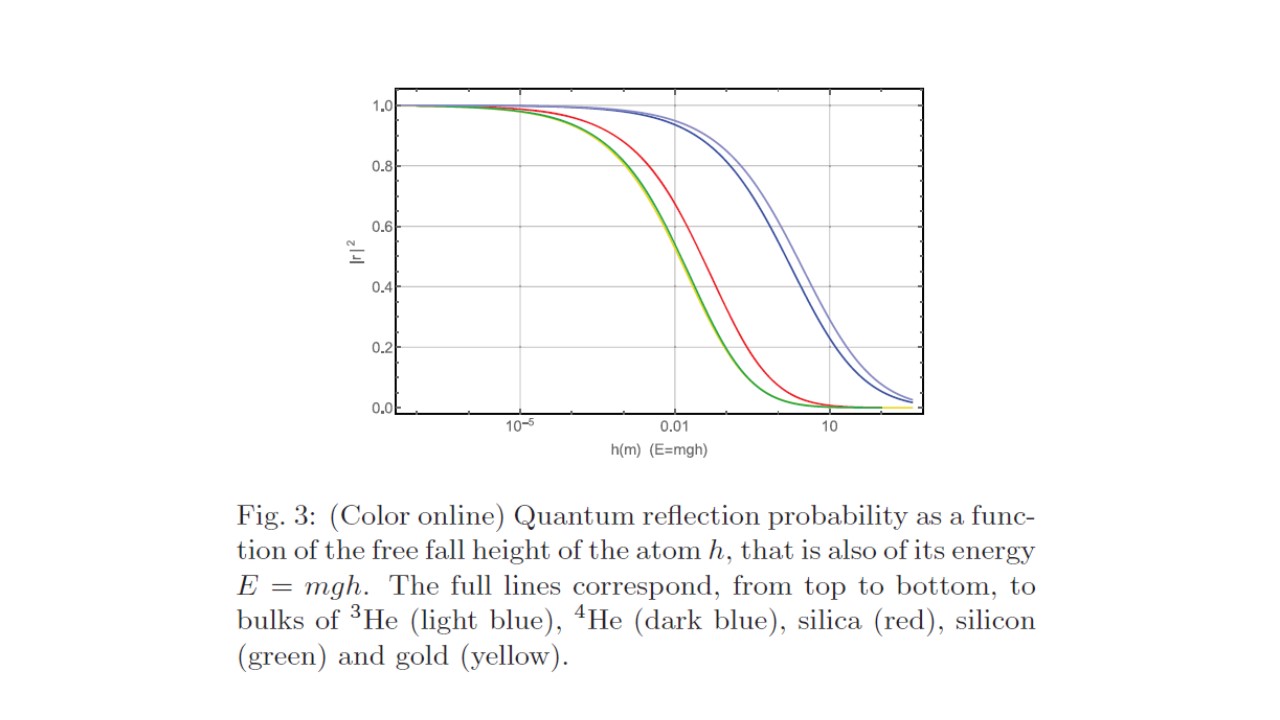Quantum reflection is a non-classical phenomenon which appears when a quantum matter wave approaches a rapidly varying attractive potential. Instead of accelerating towards the surface, the quantum particle has a probability to be reflected. This process has been studied theoretically for the van der Waals potential since the early days of quantum mechanics [1–4]. It was first observed experimentally for H and He atoms [5–7] and then for ultracold atoms or molecules on solid surfaces [8–11].
In the last years quantum reflection has been studied also for antimatter [12–14] since it should play a key role in experiments with antihydrogen atoms [15–17]. It was shown that the free fall acceleration of antihydrogen can in principle be evaluated accurately [18] through spectroscopic studies of the quantum levitational states [19,20] of atoms trapped by quantum reflection and gravity [21,22].
Following the uncertainty principle of quantum mechanics, such spectroscopic measurements should have a better accuracy for larger lifetime of antihydrogen in the trap.
We have calculated [23] quantum reflection of antihydrogen above liquid helium films and showed that the lifetime of antihydrogen reaches values as high as 1.3 s for a bulk (a thick film) of liquid 4He and 1.7 s for a bulk of liquid 3He. We are going to study all pecularities of quantum reflection with the goal of achieving maximum storage times of (anti)hydrogen atoms in gravitational quantum states, including also the effect of specular reflection of the particles in contact with surface.
[1] Lennard-Jones J. E. and Devonshire A. F., Proc. R. Soc. London, Ser. A, 156 (1936) 6.
[2] Lennard-Jones J. E. and Devonshire A. F., Proc. R. Soc. London, Ser. A, 156 (1936) 29.
[3] Berry M. V. and Mount K. E., Rep. Prog. Phys., 35 (1972) 315.
[4] Friedrich H. and Trost J., Phys. Rep., 397 (2004) 359. [5] Nayak V. U., Edwards D. O. and Masuhara N., Phys. Rev. Lett., 50 (1983) 990.
[6] Berkhout J. J., Luiten O. J., Setija I. D., Hijmans T. W., Mizusaki T. and Walraven J. T. M., Phys. Rev. Lett., 63 (1989) 1689.
[7] Yu I. A., Doyle J. M., Sandberg J. C., Cesar C. L., Kleppner D. and Greytak T. J., Phys. Rev. Lett., 71 (1993) 1589.
[8] Shimizu F., Phys. Rev. Lett., 86 (2001) 987.
[9] Druzhinina V. and DeKieviet M., Phys. Rev. Lett., 91 (2003) 193202.
[10] Pasquini T. A., Shin Y., Sanner C., Saba M., Schirotzek A., Pritchard D. E. and Ketterle W., Phys. Rev. Lett., 93 (2004) 223201.
[11] Pasquini T. A., Saba M., Jo G.-B., Shin Y., Ketterle W., Pritchard D. E., Savas T. A. and Mulders N., Phys. Rev. Lett., 97 (2006) 093201.
[12] Voronin A. Y., Froelich P. and Zygelman B., Phys. Rev. A, 72 (2005) 062903.
[13] Voronin A. Yu., Froelich P. and Nesvizhevsky V. V., Phys. Rev. A, 83 (2011) 032903.
[14] Voronin A. Yu., Nesvizhevsky V. V. and Reynaud S., Phys. Rev. A, 85 (2012) 014902.
[15] Dufour G., G´erardin A., Gu´erout R., Lambrecht A., Nesvizhevsky V. V., Reynaud S. and Voronin A. Yu., Phys. Rev. A, 87 (2013) 012901.
[16] Dufour G., Gu´erout R., Lambrecht A., Nesvizhevsky V. V., Reynaud S. and Voronin A. Yu., Phys. Rev. A, 87 (2013) 022506.
[17] Dufour G., Debu P., Lambrecht A., Nesvizhevsky V. V., Reynaud S. and Voronin A. Yu., Eur. Phys. J. C, 74 (2014) 2731.
[18] Cr´epin P.-P., Dufour G., Gu´erout R., Lambrecht A. and Reynaud S., Phys. Rev. A, 95 (2017) 032501. [19] Breit G., Phys. Rev., 32 (1928) 273.
[20] Nesvizhevsky V. V., B¨orner H. G., Petukhov A. K., Abele H., Baeßler S., Rueß F. J., St¨oferle T., Westphal A., Gagarski A. M., Petrov G. A. and Strelkov A. V., Nature, 415 (2002) 297.
[21] Jurisch A. and Friedrich H., Phys. Lett. A, 349 (2006) 230.
[22] Madro˜nero J. and Friedrich H., Phys. Rev. A, 75 (2007) 022902.
[23] P.-P. Cr´epin, E. A. Kupriyanova, R. Gu´erout, A. Lambrecht, V. V. Nesvizhevsky, S. Reynaud, S. Vasiliev and A. Yu. Voronin, EPL, 119 (2017) 33001

